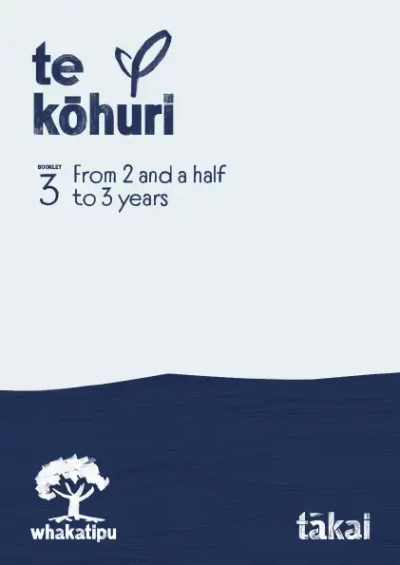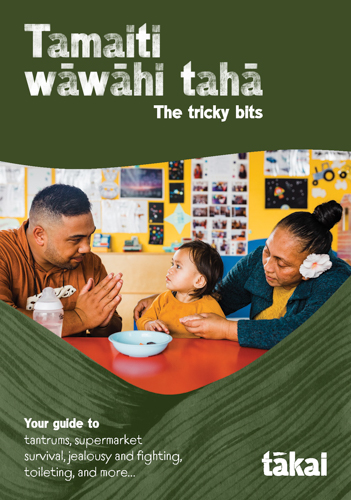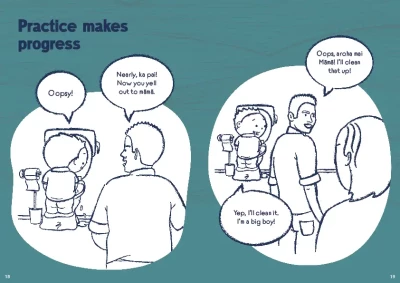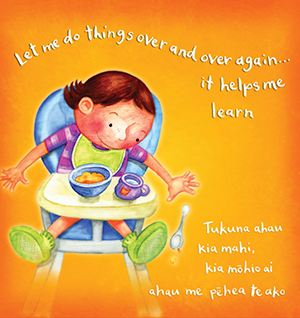
Potty or toilet learning
Some time before tamariki are 4, they will be ready to try to use the potty or toilet. Whānau can watch for the signs when their tamaiti is ready and encourage them.
Waiting for signs they're ready
Between 18 months and 4 years of age, many tamariki show they’re ready to start using the potty or toilet. Learning this skill is most successful when whānau wait for their tamaiti to show some signs they’re ready.
For tamariki with a disability, learning to use the toilet may be delayed or take longer to master, but it can be a good idea to start learning to use the potty or toilet around the same time as typically developing tamariki. In order to support tamariki to use a potty or toilet they need to be able to sit safely and independently on a toilet (using a children's seat if necessary). Whānau will know their tamaiti best.
Choose a resource that best suits whānau such as:
- Whakatipu booklet Te Kōhuri 3 — ‘ Wharepaku time’ on page 35 and the ‘Practice makes progress’ cartoon on pages 18 and 19.
- ‘The tricky bits’ pages 14 and 17.
Incontinence products are available for tamariki with a disability or medical condition that makes toileting challenging. Whānau can talk to their doctor for this support, and then get a referral to the local Te Whatu Ora Child Development Service.
Signs they're ready
Whānau can look for these signs:
- Are their nappies sometimes dry when you go to change them? If they are, that’s a sign your tamaiti can “hold on”.
- Are they interested in watching others go to the toilet? If they are, this can be helpful for learning about using the toilet themselves.
- Are they interested in talking about going to the toilet?
- Are they letting you know when they have wet or dirty nappies?
Learning to use a potty or toilet is a big step! It can take a long time to become proficient. If a tamaiti isn't ready, wait a bit longer before trying again, and keep things as calm and positive as possible.
If whānau have started to support their tamaiti in using the potty or toilet, ask how it’s going.
- What tips would you give to other whānau?
- What's something that really helped your tamaiti to learn to use the toilet?
Gentle encouragement
Here are some ideas that can help tamariki learn to use a potty or toilet:
- Warmer weather can be a good time to start. If they’re outside without a nappy on and they feel like going, they get to see what happens when they do!
- Dress them in clothes that are easy to take off and on like trousers with elastic waists.
- If you intend to use a potty, introduce it by letting toys have a go first.
- Let them sit on the potty or toilet with or without clothes. This is about them getting used to it without any pressure.
- Some tamariki respond to using the potty if they sit on it while the bath is running – the sound of water can help them wee.
- Praise them for trying, as well as for succeeding.
- Sharing picture books about young tamariki learning to use the potty or toilet can be helpful too.
Here is some advice that might help whānau.
- Start when family life feels settled.
- Look for some signs of readiness.
- Don't rush it! It can take some tamariki weeks and others months.
- A regular potty time might help, maybe before or after meals.
- Try not to make it too much of a big deal.
- If what you’re trying isn’t working, stop and try again in a couple of weeks.
- Expect accidents and avoid anger and shaming them for these.
- Often ‘wees’ will be sorted before ‘poos’.
- Days will be dry before nights – a child can be in undies all day but still need a nappy at night.
Conversation ideas
Helpful resources for whānau
-
Toilet training
Ministry of Health
Information from the Ministry of Health on learning to use the toilet, including signs children are ready.
-
When to start toilet training
Huggies
Learn the signs of toilet readiness in this article from Huggies.
 pdf 10 MB
pdf 10 MB















